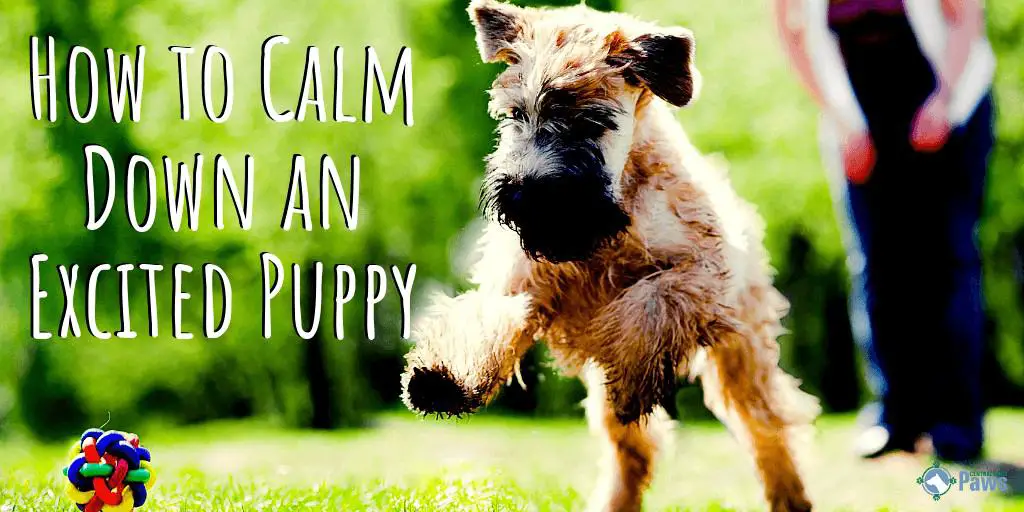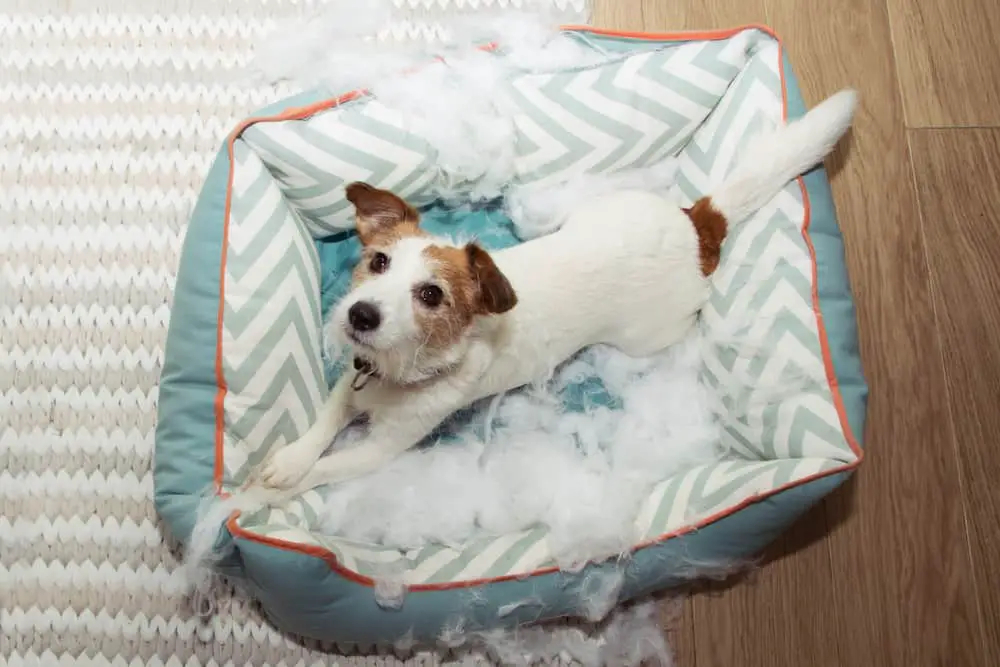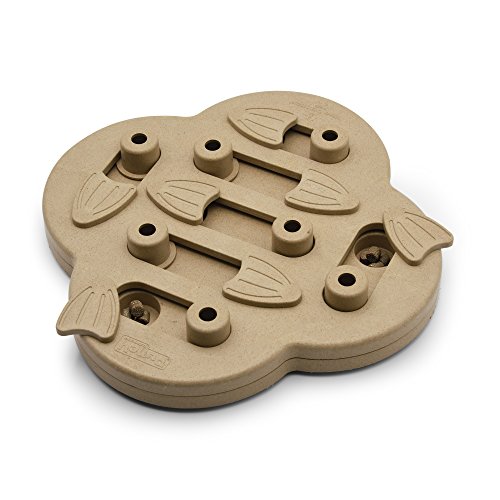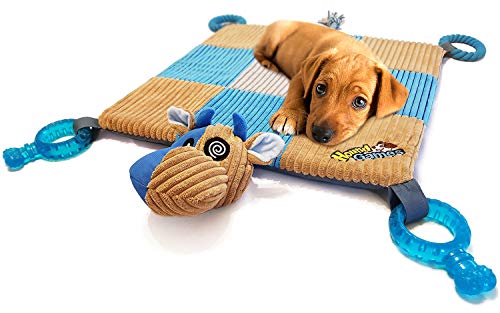I love puppies!
I love their little puppy tummies, their soft little paws, even their puppy breath.
I could watch puppies play and tumble for hours and never get bored. I think that puppies are one of life’s greatest joys, but also one of life’s greatest challenges!
When Daisy was a puppy, she was tiny and cute and one heck of a ball of energy!
Being that I had taught several puppy classes and obedience classes, I was under the misguided impression that I was all set to take on this challenge.
I couldn’t have been more wrong!
I used to walk Daisy four times a day, and that wasn’t enough to calm her down.
Eventually, I was able to get her into daycare, which was an amazing transformation. Though she was still energetic, it took off quite a bit of the excess energy.
Raising an extremely high energy headstrong puppy alone was both an eye-opening and humbling experience.
It didn’t take long for me to realize I had my work cut out for me.
Ultimately, if your puppy has too much energy, they will be fluffy balls of terror that chew, bark, and bite.
Why Is My Puppy so Hyper?
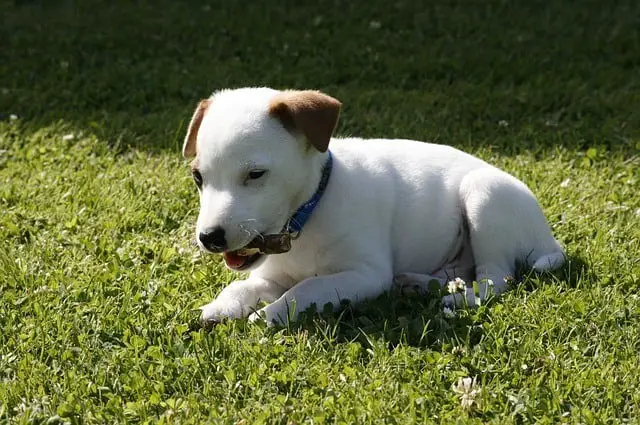
There are a few common reasons a puppy might be hyper:
- Breed
- Lack of exercise
- Lack of mental stimulation
- Overstimulation by distractions
Some breeds are more hyper than other breeds.
For example, a Jack Russell terrier is likely to be more energetic than a Newfoundland puppy.
Though, the breed of dog is not a rule, but instead more of a guide.
My family’s first Golden Retriever, Gracie, was a calm, easy to train puppy whereas my mom’s second Golden, Gussie, was a wild and crazy ball of energy.
If your puppy is crated during the day when you are at work, it is normal for your puppy to have a lot of energy to burn off when you get home.
Likely, your puppy will have been sleeping all day in your absence, so now that they are rested, they are all set to party!
Bored puppies are not that much different than bored children. They tend to find their own way to entertain themselves, which usually leads to them getting themselves into trouble.
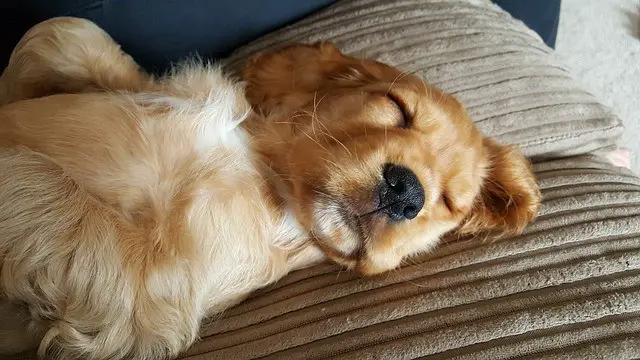
Also, if your puppy has too much stimulation, say kids running in and out or you have company over, puppies will often feed off the fun energy and become over stimulated, which can look like a hyper puppy.
All puppies have their hyper moments and we need to help them find ways to burn off that excess energy in more productive and less destructive ways.
How to Calm Down a Hyper Puppy
First and foremost, you need to make sure your puppy is getting enough exercise.
If you have a puppy that has not had a way to release some of that puppy energy it is near impossible to work with them constructively.
Exercise
The amount of exercise a puppy is getting or not getting impacts your dog’s level of energy.
Exercising puppies is a complicated task. Not enough exercise and your puppy is a demon, and too much exercise can cause significant health issues.
There aren’t any set rules or formulas for how much exercise a puppy requires.
The breed is a significant factor in deciding the amount and type of exercise your puppy should get.
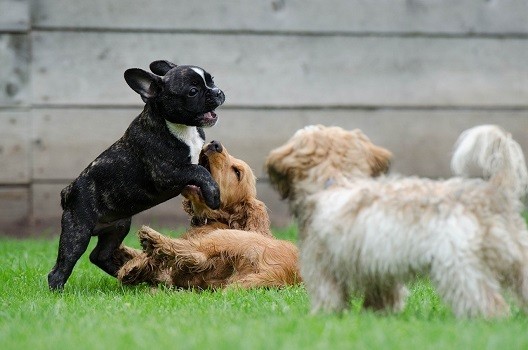
Larger dogs may seem like they can go for long walks, but too much exercise has been linked with orthopedic disease[1]. Short, low impact exercise sessions are the best.
Also, keep the exercise fun and change it up from time to time to avoid boredom.
Some great ways to exercise puppies are:
- Walks (Mix it up by going to different areas, making time to allow your puppy to explore and smell things they encounter on the walk)
- Fetch
- Swimming (Take this slow; not all dogs like the water or know how to swim)
As your puppy grows, the exercise sessions can become longer and fewer.
Also, as they become bigger and stronger, you can change the type of exercise by adding things like agility training or running.
Mental stimulation
Don’t let your puppy’s silly manner fool you into thinking that they don’t require mental stimulation.
Mental stimulation is essential to your puppy’s mental development.
The breed of dog impacts the amount of mental stimulation a puppy needs.
Breeds like Border Collies, German Shepherds, and Dobermans require more mental stimulation than other breeds.
But just like exercise, all dogs need some form of mental stimulation to keep their brains engaged.
Bored puppies can get themselves into a lot of trouble, but mental stimulation like training can help drain excess energy and help promote calm behaviors[2].
Here are some excellent ways to keep your puppy’s mind sharp:
Training
Both classroom and in-home training are effective ways to keep your puppy’s brain working.
Puzzle Toys
These toys involve your dog finding a way to access food.
Also, many puzzle toys take some time, which will give you a few minutes to get things done.
Hide and Seek
A simple and fun game that will provide exercise and mental stimulation.
Ask someone to hold or distract your puppy while you go and hide nearby.
Call your puppy randomly (like a game of Marco Polo) to keep them focused.
When the puppy finds you be sure to shower them with happy praise, but do not jump out and scare your puppy.
Remember to start with easy hiding places. This will keep your puppy from losing interest.
As your puppy catches onto the game you can hide further away from their starting point and in more challenging locations.
Find It
This is similar to hide and seek, but instead of you, they find an object or treat.
Again, start out easy.
Show them the object, place a blanket over it in front of them, then say find it.
Gradually you can increase the difficulty of where you hide the object, just make sure that is always somewhere they can reach; you don’t want to teach bad behaviors like jumping on tables.
Settle
Another way to help your puppy to settle down is to teach the “settle” command.
Yes, you can train a puppy to chill out on command!
Settle is extremely helpful when you have a high stimulation situation, such as when someone comes to the door or you have guests, but it can also be used out in public to get your dog to rest calmly on restaurant patios and such.
Settle Training Necessities
To train settle, you will need:
- Clicker – These will mark the behavior you want from your puppy.
- Small High-Value Training Treats – Soft treats work best since they are easy for puppies to consume quickly.
- Treat Tote – Helps to keep your clothes clean and makes it easy to access treats.
- Bed or Mat – You can use a towel, rug, or bed.
- Patience and a Quiet Area – Puppies get distracted easily, so the quieter an area is, the better chance of success you will have
How to Train ‘Settle’
First, if you have never used a clicker for training you will need to “load” the clicker.
You do this by clicking the clicker then immediately give your dog a treat. You will repeat this twenty times in a row.
Be sure that you are not clicking directly into your puppy’s ear. This is supposed to be positive and will teach your puppy that when they hear the noise, they will receive a treat.
Second, place the mat or bed on the floor.
When your puppy walks over onto the mat, even with one paw, click and toss the treat nearby, but not on the mat.
When your puppy comes back to the mat you will repeat this.
Do not put words to this.
Do not cue your puppy to go to the mat; just sit next to it and wait quietly.
Puppies tend to learn faster when they are able to figure it out for themselves.
Do not provide praise outside of the treat. This is a calming technique and the stimulus of your touch or voice can set your puppy into an excited mindset.
Eventually, once your puppy is consistent about coming to the mat, wait to treat until they are completely on the mat.
Then, progress to when they are laying on the mat.
When your puppy is reliably going to the mat and laying down, you can add the vocal command “settle.”
You can say “good settle” after you click and treat.
Once your puppy goes to the mat and lays down, slowly lengthen the time in between when you give treats.
Stimulation Removal
Sometimes puppies are overly stimulated and skip taking naps; this combination is a sure recipe for a demon puppy.
Imagine a child with too much sugar, but without a nap.
Essentially, puppies can get that way also.
Often, removing the puppy to a quiet area can help bring your puppy’s energy down.
You can put them in their crate with a filled Kong in a quiet room; this will help your puppy settle down.
Tips for Calming Down a Puppy
- Stay calm. Your excitement will feed your puppy’s excitement.
- Quiet, dark rooms can help reduce stimulus and aid your puppy in relaxing.
- Make sure your puppy is getting enough exercise. Remember, a tired puppy is a well behaved puppy.
There will always be times your puppy will act silly and crazy, and that’s okay some of the time.
But a puppy left in an excited state of mind for too long can cause issues for the puppy as they develop socially and emotionally[3].
Remember, patience is key.
New puppies can be overwhelming to dog parents; it’s not that much different than bringing home a baby.
There will be a lack of sleep, a lot of messes to clean up, and a lot of crying, but with patience and positive training any challenge can be overcome.
Puppies don’t stay puppies for long, so enjoy this time while you have it.
FAQs
How Do You Calm a Puppy Down at Night?
Proper exercise, full tummy, empty bladder, and a quiet, dark room with the family nearby will help calm a peppy at night.
Often puppies are separated from their family at bedtime which can be a little scary for them, so if possible, move the crate to your bedroom.
This will make your puppy feel safe and relaxed.
When (At What Age) Do Puppies Calm Down?
It varies from dog to dog, but most dogs tend to calm down between 18 – 24 months of age.
Resources
- https://www.akc.org/expert-advice/health/puppies-how-much-exercise/
- https://www.ncbi.nlm.nih.gov/pubmed/24568110
- https://pethelpful.com/dogs/Understanding-Sensory-Overstumulation-in-Dogs

